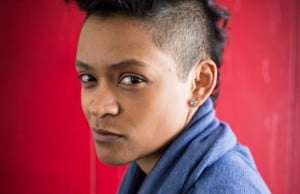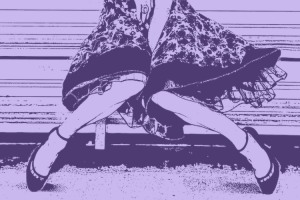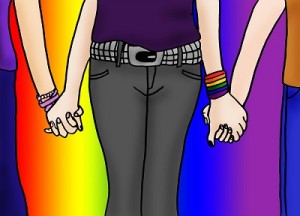“We raise girls to see each other as competitors – not for jobs or accomplishments, which I think can be a good thing – but for the attention of men,” Nigerian author Chimamanda Ngozi Adichie pointed out in her TED talk “We Should All Be Feminists.”
And it’s a good point.
Because insidiously, under patriarchy, women learn to scrutinize themselves – which often also means scrutinizing other women to see how we stack up. We see this in the way women are taught to hate the “other woman” when a man cheats on them and on dating shows that have women compete for men’s attention.
It’s hard to see a woman as a potential ally when you’ve been taught she’s your competition.
And that’s why forming supportive friendships despite this is a feminist thing to do. Because it goes against what patriarchy teaches us.
Friendships can be a means for women to help one another thrive when the cards are stacked against them, inspire one another to succeed in their careers, and teach one another about what feminism means to different people.
But friendships between women are more than an everyday interaction. With the rise of mainstream media’s interpretation of celebrity “squads” and social media #SquadGoals, they’ve become a pop culture trope. And like most tropes, this one can get a bit problematic.
Though real-life dynamics can diverge from these depictions, women’s friendships in the media are often exclusive, appearance-based, unrealistically perfect, and based on stereotypes. Not to mention, “squads” like Taylor Swift’s that are lauded as examples of feminist relationships almost exclusively consist of white women.
The problem is: When we valorize this image, we put these friendships on pedestals and obscure their potential problems. And letting it affect our real-life relationships can lead to some unhealthy behaviors. I’ve seen a number of women – particularly white women, including myself and many of those quoted in this article – internalize these tropes at the expense of inclusive and authentic relationships.
This wasn’t the original meaning of “squad goals.” Black communities have been using the term for years to refer to much-needed unity between underdogs who face struggles together. So it’s important to note that my analysis here addresses the context in which the language of “squads” has been appropriated to idolize something entirely different from that original meaning – and particularly, something that can be unhealthy to look up to.
By no means should you ditch your women friends after reading this article. That’s not what I’m suggesting. But you might reconsider how you think and talk about them, what standards you hold them to, and maybe even the way you behave toward them.
By treating our friends in an inclusive manner without stereotyping them or focusing on their appearances, we can form more feminist friendships.
So here are a few aspects of the “squad” trope we should watch out for – because they can fuel sexism instead of combatting it.
1. Exclusion
Perhaps more famously than anyone else, Taylor Swift has been making girlfriends the new boyfriends by hosting get-togethers with her favorite pals and Instagramming photos of them with hashtags like #friendspiration and #squadgoals. Unsurprisingly, then, Swift is often lauded as an example of the power of friendships between women.
But Rowan Blanchard, star of the Disney Channel’s Girl Meets World, views Swift’s “squad” and others like it a bit differently. “The ‘squads’ we see in the media are very polarizing,” she told Just Jared Jr. in a recent interview.
“Feminism and friendship are supposed to be inclusive, and most of these ‘squads’ are strictly exclusive… ‘Squad goals’ can polarize anyone who is not white, thin, tall and always happy.”
Blanchard isn’t alone in spotting the downsides of “squads.” EJ Dickson recently pointed out in Mic that “large groups of attractive young women” can bear a striking resemblance to cliques.
The back-stabbing, elitist “plastics” in Mean Girls are supposed to represent the worst of these groups – but many of the friends we see depicted more positively on TV, in movies, and in books also form exclusive cliques.
For some reason, four is often the magic number. Many book series’ that Millennial women read as kids, like The Babysitters’ Club and The Sisterhood of the Traveling Pants, contain four fairly homogenous women closer with one another than anyone else. Then, when we grew up, lots of us watched Sex and the City or Girls, both featuring groups of four privileged, white women.
Other times, like in the show Gossip Girl, there are two best friends who do everything together and rely on each other for everything.
Whatever the number, designated friend groups can foster an “us” vs. “them” mentality that values people based on racist standards.
When a woman of color is included in media friendships, like Dionne in Clueless and Lane in Gilmore Girls, she’s usually a sidekick, not the protagonist. And in real life, white women too often flock together or use friends of color to prove how not-racist they are.
Racially segregated and otherwise exclusive friendships can also encourage people to hierarchize others – because the characters are supposed to feel special for being part of the group. And in order for some to feel special for being included, others must be excluded.
The strict demarcation of friend groups can carry over into real life. There was even a clique in my junior high school that coined themselves “The Naughty Nine.”
By enumerating their posse, they capped themselves, making it crystal clear that they were not the Naughty Ten. Many “squads” have this unspoken rule: new members need not apply. This discourages solidarity among women and puts those who are considered attractive by patriarchal standards above those who are not.
2. Concern with Appearances
Taylor Swift’s affinity for showing off her superstar companions on social media gives the impression that she’s accumulating human symbols of her own popularity. As Dickson puts it, they’re the “famous friends she collects and displays onstage like Beanie Babies.”
Even if she isn’t making these friends to win a popularity contest, they’ve earned her the title of “the most popular human alive” – and since her group is so exclusive, they can make the rest of us feel unpopular.
Large squads encourage the perception that the more friends you have, the more appealing you are, and if you don’t have as many friends to show off (especially on stages or at pool parties like Swift’s), there’s something wrong with you.
When I see women post photos of their “#BFFs” or “#squads” hanging out all over social media, I can’t help but wonder whether they’re trying to let the world know what good friends they are – especially since the photos usually feature conventionally beautiful women doing fun-looking activities.
I don’t doubt that Taylor Swift and other women active on social media are actually friends with the people in their photos. But when a friend becomes a means to show off your own social capital and gain “likes,” you’re using them.
You’re also valorizing an image of your friendship rather than appreciating your emotional connection. If you’re confident in a friendship and value it based on how it affects you internally, you won’t feel the need to see it validated online.
With friendship bracelets and “squad goals” shirts, friendships have become commercialized, and women have been taught to think about how their friendships (like everything else in their lives) look.
Social media already can mess with women’s body image by promoting pressure to look flawless, even when they #wokeuplikethis, and constantly happy. Now, our Instagram photos, Twitter followers, and Venmo payments also reveal to the world how many and what kind of friends we have.
And I know how powerful the desire to project the image of a perfect social life can be. I’ve bought into it myself.
In seventh grade, my friends and I would make web pages featuring cartoon girls that were supposed to represent us. I always included my closest blonde friend, because I’d gotten the impression from the media that every group of girlfriends must include a blonde.
Looking back, I probably spent more time at school with her than I would’ve if she were a brunette. I wanted my friends and I to look like the friends I saw on TV as we walked down the hall – the ones who could always lean on each other even when the popular kids didn’t like them.
Well into my adulthood, I tagged friends in Facebook posts so people would know we were close enough for me to tag them. I only did this with the impressive, conventionally attractive, and “cool” friends I wanted to be associated with.
Even when I tagged them ostensibly to congratulate them on publishing a book or acting in a movie, I knew what I was doing: I was letting everyone know that I, Suzannah Weiss, was capable of befriending people who wrote books and appeared in movies.
I wanted to be like Taylor Swift. I wanted to be like all the real-life women I’d seen tagging each other. I wanted to appear worthy of that level of devotion, too. I didn’t want to be the loser who had nobody to tag.
But this should not be what friendship is about. Those special moments that we share with our friends should matter just as much even when there’s no camera phone around to capture them – and no audience to “like” them.
3. Unrealistic Standards
Growing up, my favorite show was Lizzie McGuire, and my favorite movie was Romy and Michele’s High School Reunion. Both center on friendships between two women with a superlative bond. Lizzie calls Miranda to discuss every conflict in her life, and Romy and Michele live together, open a shop together, and don’t have other friends because they only need each other.
But in addition to valorizing exclusion like I mentioned, this “BFF” trope sets up the unrealistic expectation that one person will meet all our needs.
I spent my adolescence searching for the best friend I thought I needed. I thought I was a misfit for not finding one consistent companion whose world centered around me.
But as I got older, I gave up that dream. I realized that some friends are better for confiding in after a breakup, while some are better for a fun night out, and that valuing any one person or group above others can be hurtful and unhealthy.
Media friendships can also possess perfection and “normalcy” that aren’t attainable for everyone. Sure, women on TV get into fights, but they’re usually based on minor – or at least understandable – offenses and are followed by heartfelt apologies or laughter.
“I feel like a lot of the female relationships I see on TV or in movies are in some way free of the kind of jealousy and anxiety and posturing that has been such a huge part of my female friendships,” Lena Dunham once told Interview Magazine. Dunham’s show Girls contributes to pop culture’s image of women friends as coming in groups of four white women, but the complexity of her characters is rarer in the media.
Relationships between women aren’t inherently dramatic or catty, but they’re not one-dimensional either. Sometimes people, no matter what their gender, don’t see eye to eye. Sometimes they say things that wouldn’t appear in any movie script.
And oftentimes, “BFFs” aren’t really forever.
The media teaches us as many ideals surrounding friendships as it does surrounding romance, but the former more often go unchallenged.
4. Stereotyping
Cultural notions of women’s friendships are often gender-specific: “Girlfriends” are for gossipping, gay men are for fashion advice, and straight men are potential love interests.
But there’s nothing about anyone’s gender that should automatically determine what kind of friendship you have with them.
In fact, it can be harmful to assume someone wants to do certain activities with you just because of their gender.
The overall glorification of women’s friendships is also often based on stereotypes. “Friendship between women is different than friendship between men. We talk about different things. We delve deep,” Jane Fonda said in an interview with Vanity Fair.
This view encourages toxic masculinity by making emotions women’s domain and contributes to the stereotype that women are more emotional.
Generalizations like this are often essentialist and consequently cissexist. A lot of think-pieces in recent years have been throwing around the term “female friendship” and presenting it alongside descriptions of relationships between female animals.
A New York Times article on “the spirit of sisterhood” compares the characters of HBO’s Girls to monkeys, elephants, mice, and horses, arguing that in nature, “mutually beneficial relationships between females turn out to be the basic unit of social life.”
Though “female friendship” usually means “friendship between women” in these contexts, this phrasing excludes trans women, as do biological explanations for women’s supposedly unique bond.
“Women” are not the same as “females,” and narratives of female friendship that trace it to biology conflate the two, promoting a narrow definition of “woman.”
Stereotyping friends generally prevents you from getting to know them, which is what friendship should be all about.
***
There’s a popular stereotype that women are catty and dramatic, and I don’t endorse that view.
Women aren’t innately concerned with exclusion, appearance, perfection, or stereotypes.
But that’s how the media presents us, and it’s difficult not to internalize these ideals and strive toward them.
Women can be more than that, though. We can be friends genuinely, not because we’re part of the same “squad” or because we do “girlfriend” activities or because of some essentialist biological bond – but because we respect and admire one another.
But beyond that, women’s friendships should not be a special class of friendships in the first place. Nobody’s gender, race, or sexual orientation has to determine what type of relationships they form.
Instead, we should be free to explore whatever connections we want with whomever we want, and a social script for our gender’s friendships look like shouldn’t limit anyone.
[do_widget id=’text-101′]
Suzannah Weiss is a Contributing Writer for Everyday Feminism and a New York-based writer whose work has appeared in The Washington Post, Salon, Seventeen, Buzzfeed, The Huffington Post, Bustle, and more. She holds degrees in Gender and Sexuality Studies, Modern Culture and Media, and Cognitive Neuroscience from Brown University. You can follow her on Twitter @suzannahweiss.
Search our 3000+ articles!
Read our articles about:
Our online racial justice training
Used by hundreds of universities, non-profits, and businesses.
Click to learn more





















